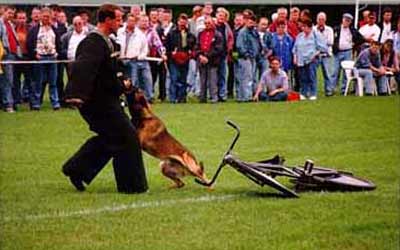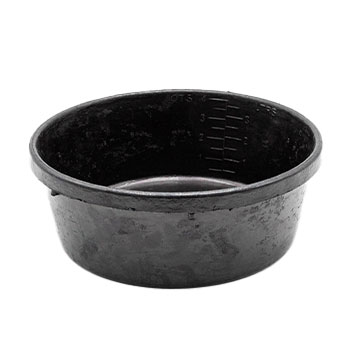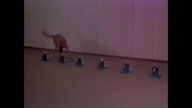Training the 'Guard the Large Article' Exercise in KNPV
Ed's Note: The following article was written by a Dutch friend of mine. Bob Neijts has been involved with the KNPV sport for 15 years. I have intentionally not edited any of the article. While the English may not be correct, you will get the flavor of the people who train KNPV from this article.

In this exercise the dog has to find an large object (mostly a wooden box) which is hidden in the woods and has to bark at it as long as it takes his handler to come to him. Actually the training of this exercise starts as a very young dog. The first thing your dog has to learn is to bark on command. That is why I repeat the bark exercise first.
Step 1
As soon as your pup is 8, 9 or 10 weeks old you can start with this exercise. You can either do it by encouraging him whenever the dog is barking to praise him and say the command "loud" over and over again or you can try to make the dog bark by stimulate him in another way. I prefer the second possibility.
The best thing to use is his food pan. Is very easy to make the dog bark every time he gets its food and from this point to teach him to bark as soon as you give the command. Just play with him with the food pan but make it impossible for him to get to his food. Because the dogs prey drive is taking over and the fact that it is impossible for him to get his food (prey) he gets easily agitated which will make him bark in 99% of the cases.
Instead of his food pan you can also use a ball or other toy. Later you can combine the two. Start with the food pan and then move on to the toy.
Step 2
As soon as your dog understands the command "loud" you can start using the wooden box. Now you place the food of the dog in the wooden box. Before he is allowed to eat he has to bark at it. At first a few barks is enough but you have to work on making this time longer and longer. Even make him bark at it for a few minutes. Always be careful here. When your dog is loosing interest because it takes to long you make him bark one more time and give him his food. Make sure that you always end the exercise by the dog obeying your command! So no bark No food! Even make him wait until the next day if necessary!
After a short time he will bark at the box without him seeing you place the food inside it. Now you start using a ball or other toy. When he does well and barks at the box you give him his ball instead of his food. Let him play with it for a moment before you get back to the training again. If a toy doesn't work but a piece of food will you just stick to the food! You have to find out yourself what works best.
When he is used to bark at the box lift him up and make him stand on the box with his front paws. Repeat this again and again by lifting him up or knock on the box and say "place." Finally he will understand and stay. You always work the dog on leash. When you stand next to him you keep the leash tight and when he steps off the box you just lift him up again and say "place."
When he stands on the box it is easier to make him stay near the box while he barks and prevent him from chewing on it.
Step 3
While you were able to train the first steps at home now it is time to move on to the training field. Now first you place your dog at post and place the wooden box in front of him unable for him to reach. Give him the command "loud" and make him bark at it. If he does well you place the box at a short distance away from you. Lets say 20 meters. You get your dog (on a long line) and walk towards the box. Now you give him the command " Search" (Dutch = revier) and you run along with your dog to the box. At the moment you arrive at the box you give him the command "loud" and make him bark at it. Immediately lift him up and make him stand on it. Make him bark a few times and give him his award. You can repeat this once or twice on the same training session.
When your dog performs well you increase the distance. Make somebody else place the box somewhere on the field. Now you arrive on the field. Your dog may still be able to see the box. If this works well you place the box at the edge of the field where the trees start. Still place it in sight. Repeat the whole exercise again and again.
Every time you make the distance a little bigger and make him bark at the box a little longer.
Step 4
Now starts a more difficult part of the exercise. You have to move in to the woods. At first you place the box at a short distance into the woods, still in sight and repeat the whole thing. Slowly you place the box further and further into the woods. Now you need two or three other persons to place the box in the woods and lay a few tracks. If your dog understands the exercise it will be no problem to make him search for the box. The total distance will be something like 100 or 150 meters.
Don't forget to use a judge, different people to lay the tracks, different locations, different distances and different times of day when you train.
If you train step by step and you make sure your dog understands everything 100% before you move on there will be not much troubles. Still keep an eye on him. Train on a long line once in a while!
Problems
Although it sounds more easy as it is in practice you can teach this exercise to every dog. The problems trainers have with this exercise are often created by themselves and not by the dog!
The most important mistake they make is that they want to move to fast!
Not Barking
If the dog knows the exercise but barks a few times at the box and then stays quiet the handler has to move back to step two! Start all over again and make the dog bark as long as want him to! Use a method without any force. Punishing the dog will take you nowhere. You have to make your dog understand that he can reward himself by barking. There are a few possibilities:
- Use the food pan. Give him no food until he barks! Make sure you win! Don't give in. Even if it takes two days without eating for the dog. Don't worry he will not die. As soon as he barks even a little give him just a little piece of food. You will win in the end. If the dog starts barking you use the command on a lot of different occasions. Make him get used to it and praise him like you never did before. Now move on to the next step and so on and so on.
- Place your dog on a post. walk away from him for about 50 meters and turn around towards him. Give him the command. If he starts barking you slowly start to walk towards him. When he stops barking you stop walking. Take your time. Make him bark before you move. Say the command with an enthusiastic and encouraging voice. As soon as he understands it and starts barking praise him! Train this part well before you move on to the next step. Be sure he barks on command.
- Agitate him. Tease him with the box. Make him want to go after it. This can be a little tricky because it is possible that he wants to chew it up instead of barking at it. That is why you have to make sure he will not be able to get to the box. Keep him away of just for a few inches. He will get so excited that he will start barking. When you do this often enough he will get exited every time he sees the box. Make him bark will be no more problem then. Keep it fun and give him a reward when he does well!
Chewing / Scratching
This can be very difficult to correct whenever you dog has make these things as a habit. You have to move back your training. Work your dog on a short distance and use a box made out of a material he cannot chew on, like metal.
Your dog has to perform 200% before you increase the distance or make him work out of sight. Don't give him the change to make a mistake. Maybe the training will take a little longer but the result is worth the effort. There are also a few other possibilities to solve this problem. One of the is a device to give the dog a electrical correction whenever he touches the box. On the edges of the boxes there are some metal strips. In the box is a small battery connected to the strips. When the dog wants to chew on the box he will place his teeth on one of the edges and will get a minor electrical shock.
Another option is to place somebody up in a tree a few meters away from the box. As soon as the dog starts to chew on the box he can either give him a verbal command or for example throw a bucket full of water over the dog.
All the different problems that may occur are the result of some mistake during training. Be honest with yourself and try to find out where you made this mistake and what you did wrong. As soon as you realize that the solution of your problem is already there. Go back a few steps in training and start all over again. Take your time and be patience. Give your dog the time to learn and keep it fun for the both of you!









Ask Cindy.